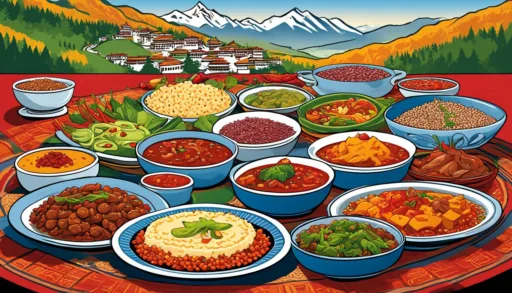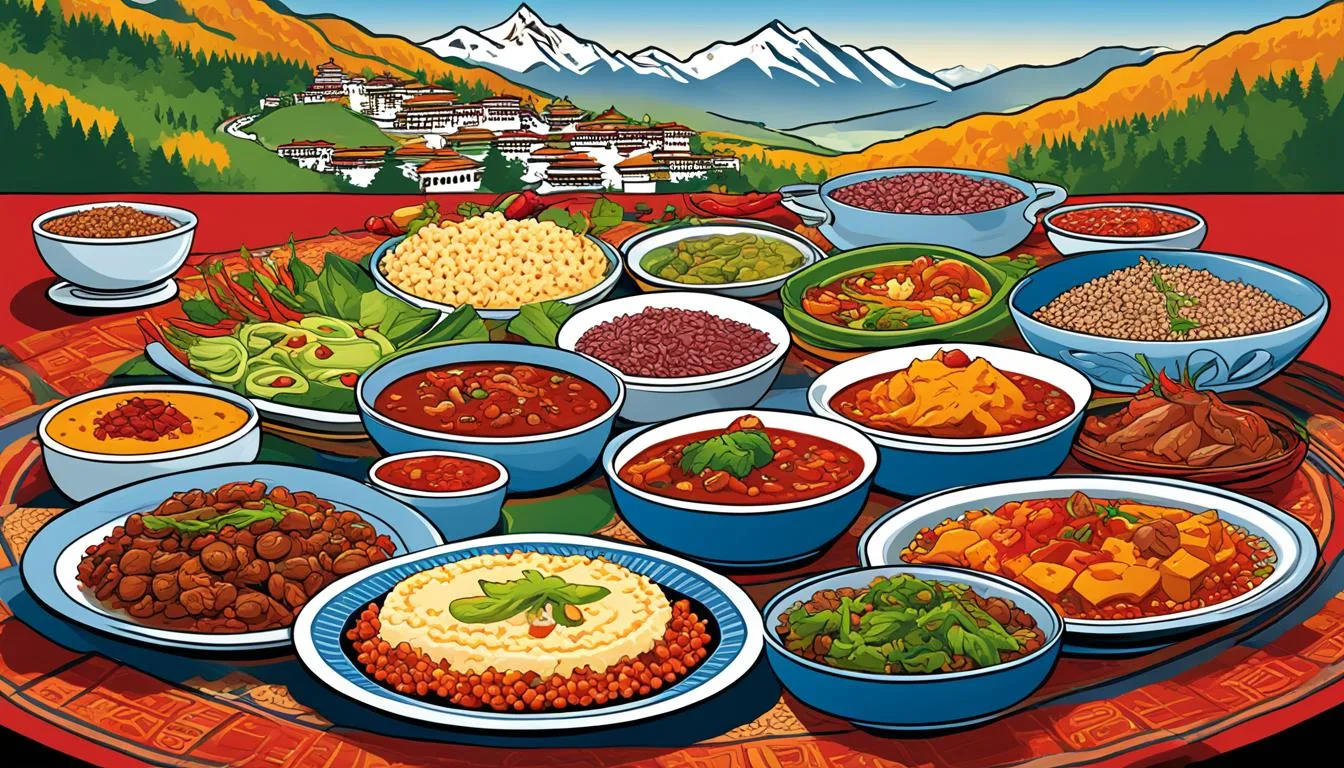In a country where chili peppers are considered a vegetable rather than a spice, the Bhutanese culinary landscape offers an extraordinary expedition for the senses. Nestled amidst the mighty Himalayas, Bhutan holds not just a treasure trove of natural beauty but a hidden gastronomic wonderland waiting to be explored. With fewer than 800,000 inhabitants, this serene kingdom boasts a culinary diversity that is as vivid and distinct as its culture. Bhutanese culinary discoveries are not only about traditional Bhutanese food; they represent a seamless blend of flavors, ingredients, and traditions that epitomize the essence of Bhutanese cuisine.
While acknowledging the culinary riches of countries like Italy or Japan, it’s easy to overlook the small yet flavor-packed kingdom of Bhutan. Here, each dish narrates a story of harmony with nature, spiced up by the nation’s love for chilies and tempered with the creamy richness of cheese. The mystical allure of Bhutan transcends beyond its monasteries and mountains to find a profound expression in its food, crafting a uniquely Bhutanese experience that leaves both locals and visitors craving for more.
Key Takeaways
- Discover how chilies are not just a spice but a staple vegetable in Bhutanese cuisine, brightening dishes with heat and flavor.
- Learn about the role of traditional Bhutanese food in weaving a tapestry of tastes that reflect Bhutan’s cultural identity.
- Uncover the secret ingredients that make Bhutanese cuisine stand out in the burgeoning scene of world gastronomy.
- Explore the significance of cheese in Bhutanese dishes, providing a comforting creamy balance to the fieriness of the chilies.
- Experience the holistic aspect of Bhutanese meals that blends satisfaction for the palate with nourishment for the body and soul.
The Essence of Bhutanese Cuisine: A Harmony of Spices and Simplicity
Embracing the heart of Bhutanese food culture, the cuisine serves as a tapestry of the nation’s rich heritage woven through its ingredients and Bhutanese cooking techniques. Central to this culinary tradition is the integration of a specific array of Bhutanese spices, which play a pivotal role in delivering the complexity amidst the apparent simplicity of the dishes. This intrinsic combination of health and flavor showcases Bhutan’s respect for both nature and nourishment.
The unquestionable mainstay of the Bhutanese meal is rice, especially the indigenous red rice, which is a treasure trove of nutrients. This medium-grain staple, when paired with the heat of locally sourced chilies and the creaminess of homemade cheese, transports one to an authentic Bhutanese gastronomic journey. It’s not merely about the heat but rather the distinct spicy-yet-comforting personality that these dishes offer, making them a true reflection of the local food culture.
Let’s delve further into the cornerstone spices and seasonings that elevate Bhutanese cuisine to its revered status:
- Ginger and garlic: These foundational ingredients form the aromatic bedrock of many dishes.
- Sichuan pepper: Known for its unique tingling sensation, it adds depth and warmth without overpowering the dish.
- Turmeric: A dash of this golden spice brings an earthy nuance and its well-documented medicinal properties.
The art of Bhutanese cooking lies in balancing these spices in a way that they do not overshadow the natural taste of the main ingredients but rather blend seamlessly to produce sublime flavors.
| Ingredient | Role in Cuisine | Health Benefit |
|---|---|---|
| Ginger | Aroma and Spiciness | Digestive Aid |
| Garlic | Flavor Enhancer | Antibacterial Properties |
| Sichuan Pepper | Warming Spice | Stimulates Circulation |
| Turmeric | Color and Depth | Anti-Inflammatory Effects |
| Chilies | Heat and Boldness | Boosts Metabolism |
| Homemade Cheese | Creaminess and Tang | Source of Calcium |
This holistic approach to food, inherent to the Bhutanese food culture, underpins the nation’s diet with the dual purpose of delivering joy to the palate and vitality to the body, epitomizing the spiritual and physical synchrony that is fundamentally Bhutanese.
Bhutanese Culinary Discoveries: Staple Ingredients That Define a Nation’s Palate
Beneath the towering Himalayas, Bhutan’s traditional cuisine unfolds as an array of vibrant flavors rooted in its staple ingredients. These unassuming yet essential components not only offer a peek into the daily life of Bhutanese communities but also reflect the nation’s commitment to purity and sustainability. Let’s delve into the nutty delight of Bhutanese red rice, the fierce combination of chili and cheese, and the recent shifts toward organic farming practices.
The Nutty Delight of Bhutanese Red Rice
“Bhutanese red rice”, an indispensable element of Bhutan’s diet, reigns as much for its taste as for the nourishment it offers. Cultivated in the mineral-rich waters of the Paro Valley, it imparts a signature nutty flavor, transforming the simplest of Bhutanese recipes into soulful meals. Let’s explore how this hearty grain takes center stage in daily nourishment.
The quick-cooking attribute of this rice can be accredited to the unique irrigation from the Himalayan glacial waters, resulting in a wholesome ingredient that complements the busy lives of the Bhutanese people.
Chili and Cheese: The Cornerstones of Bhutanese Flavor
One cannot speak of “Bhutanese cheese” without invoking the heat of the region’s chilies — a dynamic duo that forms the cornerstone of many traditional dishes. In the realm of Bhutanese cuisine, both ingredients expand beyond their roles as mere flavoring agents to become the heart and soul of every palate.
Far from mere condiments, chilies blaze through the recipes while the home-crafted ‘Datshi’ cheese made from cow’s or yak’s milk merges seamlessly, lending a distinctive creamy and tangy flavor.
This iconic pairing is especially evident in the country’s adored national dish, Ema Datshi, which marries the two in a fiery yet comforting embrace.
Organic Farming: A Step Towards Sustainability in Bhutanese Cooking
In recent years, Bhutan has championed “organic farming in Bhutanese cuisine”, with an aspiring vision to become a fully organic nation. This dedication not only reflects in the high-quality, chemical-free ingredients that grace Bhutanese tables but also aligns perfectly with the country’s environmental philosophies.
- Embraces local, seasonal produce
- Reduces environmental impact
- Aligns with traditional Bhutanese values
| Ingredient | Source | Culinary Use | Organic Farming Influence |
|---|---|---|---|
| Bhutanese Red Rice | Paro Valley | Main meals, desserts | High-altitude organic cultivation |
| Cheese (Datshi) | Local dairies | Datshi dishes, snacks | Traditional cheese-making practices |
| Chilies | Local farms | Ema Datshi, condiments | Organic practices enhance flavors |
Transitioning to organic farming methods is a testament to Bhutan’s foresight in preserving its rich culinary traditions while safeguarding the Earth. This embrace of organic farming ensures that Bhutanese cuisine not only offers delectable “Bhutanese recipes” but does so with the utmost respect for nature and future generations.
Iconic Dishes That Tell the Tale of Bhutan
Encounter the heart of Bhutanese heritage through its Bhutanese culinary discoveries. Where the chill of the Himalayan air meets the warmth of robust flavors, traditional Bhutanese dishes tell stories of the nation’s rich and vibrant culture. Signature to the Bhutanese dining experience is Ema Datshi, a bold blend of chilies and cheese that comfortably sits at the pinnacle of Bhutanese cuisine.
The art of crafting perfection in a bowl is seen in Jasha Maru, a chicken stew brimming with the zest of ginger, garlic, and chilies; a true reflection of Bhutan’s gusto. Unwind with the comfort of Phaksha Paa, where succulent pork pieces are simmered with red chilies and mixed vegetables – a culinary hug in the brisk Himalayan weather. No culinary journey through Bhutan would be complete without savoring Momos, the Bhutanese take on dumplings, offering a delicious vehicle for meat or vegetables, paired with a tantalizing spicy dip.
Here is an overview of the dishes that are essential to the local cuisine and have become a source of pride for Bhutanese people.
| Dish | Main Ingredients | Flavor Profile |
|---|---|---|
| Ema Datshi | Chilies, cheese, optional green beans, mushrooms, or potatoes | Creamy, spicy |
| Jasha Maru | Chicken, ginger, garlic, chili | Savory, robust |
| Phaksha Paa | Pork, red chilies, radishes, leafy greens | Hearty, spicy |
| Momos | Meat or vegetables, dough, dipping sauce | Rich, flavorful |
These cornerstone dishes epitomize the harmonious fusion of simple ingredients and profound flavors, presenting an authentic taste of Bhutan that remains etched in the memory of travelers and cherished by locals alike.
Unlocking the Secrets of Bhutanese Spices and Herbs
Delving into the heart of traditional Bhutanese cooking, a rich tapestry of nuanced flavors is revealed, orchestrated by the deliberate and skilled use of Bhutanese spices and herbs. These ingredients are much more than mere additives; they embody the intricate relationship between cuisine and wellness that is deeply ingrained in Bhutanese culture.
Bhutanese dishes are renowned for their ability to enliven the palate without overwhelming it. The use of Bhutanese herb usage and spices imbues each dish with a character that is both distinctive and subtly complex. Among the pantheon of flavors, ginger and garlic lay the aromatic foundation, providing a warm and inviting base that beckons the senses.

Let’s take a closer look at some key spices and herbs that define the culinary landscape of Bhutan:
- Ginger (Zingiber officinale): A cornerstone of many recipes, offering a peppery-sweet warmth.
- Garlic (Allium sativum): Valued for its pungent and savory depth, essential in many sauces and stews.
- Sichuan Pepper (Zanthoxylum): Known locally as thingye, imparts a distinctively zesty buzz.
- Turmeric (Curcuma longa): Contributes a golden hue and a gentle earthiness, believed to have numerous health benefits.
The use of these spices is more than flavoring; it’s a holistic approach to nourishment that captures the essence of Bhutanese philosophies. They not only enhance taste but also contribute to the health-giving qualities that are so appreciated in this Himalayan kingdom. The delicate balance and healthfulness of foods are a direct reflection of the principles of Buddhist thought that influence all aspects of Bhutanese life.
| Spice/Herb | Common Uses | Associated Health Benefits |
|---|---|---|
| Ginger | Marinades, soups, and teas | Helps with digestion, reduces nausea |
| Garlic | Seasoning base for curries and sauces | Boosts immunity, possesses antibacterial properties |
| Sichuan Pepper | Seasoning for meats and vegetables | Stimulates circulation, aids pain relief |
| Turmeric | Rice dishes, curries, coloring agent | Contains anti-inflammatory compounds, promotes brain health |
To truly understand the fascinating world of Bhutanese spices, one must experience how they coalesce in harmony within dishes that speak to both the palate and the spirit. These spices are the anchors of authenticity, threading the past with the present in a continuous melody of flavor that is emblematic of Bhutan’s culinary heritage.
Beverages in Bhutan: From Butter Tea to Ara
In the realm of Bhutanese beverages, the country’s gastronomic landscape is uplifted through the cherished rituals associated with their traditional drinks. Among the most celebrated is the Butter Tea, a distinctive concoction that offers warmth and nourishment, particularly against the backdrop of the Himalayas’ bracing weather. This tea is more than a mere warm beverage; it exemplifies the Bhutanese approach to blending nourishment with comfort.
The process of making Butter Tea involves a careful churning of tea leaves, butter, and a pinch of salt, producing a rich and creamy blend that is both energizing and satisfying. The presence of this tea is ubiquitous across the country and serves as a testament to the Bhutanese preference for flavors that are both bold and soothing.
Another staple in the Bhutanese repertoire of spirits is Ara, a traditional alcoholic beverage that captures the celebratory spirit of Bhutan’s festivals and special occasions. Crafted through the distillation of rice, wheat, or barley, Ara has a potent significance in the country’s cultural and social gatherings.
Festivities in Bhutan are incomplete without the enjoyment of Ara often accompanied by singing, dancing, and a sense of communal unity. It signifies more than just a drink; it is a symbol of Bhutanese hospitality and the joyous spirit of their cultural landscape.
Bhutanese traditional drinks such as these are not only deeply ingrained within the local lifestyle but also provide a glimpse into a culture that values the interconnection between nourishment, tradition, and social communion. The act of drinking Butter Tea or Ara transcends the mere act of consumption and turns into a practice rich with cultural resonance.
| Beverage | Main Ingredients | Occasion | Cultural Significance |
|---|---|---|---|
| Butter Tea | Tea leaves, Butter, Salt | Daily/High altitude regions | Warmth and sustenance |
| Ara | Rice, Wheat, or Barley | Festivals and Celebrations | Symbol of hospitality and celebration |
As we delve deeper into the essence of Bhutanese traditional drinks, it becomes clear that these beverages are multifaceted symbols of Bhutan’s cultural identity. They offer more than taste; they are carriers of tradition, each sip a nod to the land’s rich culinary and cultural heritage.
Dining Etiquette in Bhutan: More Than Just a Meal
Embracing the subtleties of Bhutanese dining etiquette goes beyond understanding the dos and don’ts at the table; it’s an intimate glimpse into the heartbeat of Bhutanese food culture. Meals in Bhutan are more than sustenance; they are social events that reinforce the bonds of family and community.
Communal Eating: Understanding ‘Tshog’ and its Importance
Central to Bhutanese communal dining is the concept of ‘Tshog’, which is deeply embedded in the spiritual and cultural fabric of the country. During religious occasions and festivals, the practice of Tshog comes to the forefront, where individuals gather to share meals as an expression of unity and fellowship. This act of communal eating is not only about nourishment but serves as a platform for exchanging stories, fostering friendships, and upholding the community’s intertwined destiny.
Traditions of Hospitality and Generosity at the Bhutanese Table
Bhutanese hospitality is characterized by an unspoken rule where the act of offering and sharing food transcends a mere polite gesture—it’s considered a moral imperative. When you’re invited to a Bhutanese home, expect to be greeted with generous offerings that are both a display of warmth and a measure of respect. A visitor turning down food is rare since it’s understood that doing so can signify a breach of cordiality within the deeply interconnected society.

At a typical Bhutanese meal, certain customs are adhered to reverently—such as the practice of letting the eldest at the table begin eating first, symbolizing respect and adherence to familial hierarchy. To foreigners, these small acts reveal a layer of Bhutanese culture that can only be experienced through the intimate act of sharing a meal. As one navigates the rich tapestry of Bhutanese communal eating, it becomes evident how closely knit the threads of food and culture truly are in this Himalayan kingdom.
Regional Delicacies: Exploring Diversity Across the Bhutanese Landscape
As travelers venture through the serene kingdom of Bhutan, they encounter a mosaic of flavors that offer a taste of the distinct Bhutanese regional variations. These regional specialties reflect not only the unique climates and topographies but also the ingrained culinary wisdom passed down through generations. Let’s delve into the traditional Bhutanese food that defines the local palate and exemplifies the country’s resourceful use of native ingredients.
In enriching the gastronomic tapestry, regional Bhutanese delicacies originate from meticulous cooking practices that value both flavor and nutrition. From Central Bhutan’s hearty meat stews to Western Bhutan’s vegetable-laden dishes, every region has a unique culinary story to tell. The table below encapsulates this very diversity, drawing a delicious map of Bhutanese cuisine across different regions.
| Region | Main Ingredient | Signature Dish | Flavor Profile |
|---|---|---|---|
| Western Bhutan | Vegetables | Kewa Datshi (Potato Cheese Stew) | Creamy and Spicy |
| Central Bhutan | Yak Meat | Yaksha Shakam (Dried Yak Meat) | Rich and Savory |
| Eastern Bhutan | Pork | Phaksha Paa (Pork with Chili) | Spicy and Piquant |
This exploration of regional tastes not only pleases the palate but also conveys the impressive adaptability of the Bhutanese people. Their ability to thrive and create culinary wonders with the resources available epitomizes a profound connection to their land’s bounty. The next time you find yourself in the land of the Thunder Dragon, let these regional delights guide your journey through Bhutan’s edible ethos.
Buddhism and Bhutanese Cuisine: A Symbiotic Relationship
The essence of Bhutanese cuisine is deeply rooted in Buddhism influence on Bhutanese cuisine, a philosophy that intertwines spiritual mindfulness with every aspect of daily life, including food. An intrinsic respect for living beings and the Buddhist practice of non-harm resonate within Bhutan’s culinary tradition. This reverence manifests as a mindful inclusion of meat, with Bhutanese people often choosing to consume meat that has not been killed specifically for them, reflecting a nuanced balance between dietary preferences and spiritual ethos.

Bhutanese Buddhist traditions, also integral to local gastronomy, encourage communal dining experiences as a gesture of fellowship and unity. One of the most heartfelt expressions of this is Tshog, a shared meal during religious observances. Here, the acts of cooking and eating are communal, symbolic of the larger Buddhist values of sharing and community well-being. Such Bhutanese cultural practices create bonds that transcend the mere act of eating, fostering social coherence and collective mindfulness.
Here is a glimpse into how Buddhism molds the dietary habits of this Himalayan nation:
- Tshog – Communal meals serving as a conduit for togetherness and spirituality.
- Meat consumption – Practiced with mindfulness, often only eating what is available rather than engaging in animal slaughter.
- Fasting rituals – Certain Buddhist festivals involve fasting, underlining the practice of self-restraint and inner purity.
- Vegan and vegetarian dishes – A substantial part of the diet for many, especially monks, complementing non-violence principles.
In conclusion, the symbiosis between Bhutanese Buddhist traditions and the nation’s culinary culture is profound, each aspect feeding into the other, creating a rich tapestry of food practices that are both nourishing to the body and uplifting for the soul. It’s this union of ethics, taste, and social custom that makes the Bhutanese food experience uniquely enlightening.
Sustainability at the Heart of Bhutanese Culinary Practices
Sustainability in Bhutanese cuisine is an ingrained philosophy, reflecting a profound respect for natural harmony. In Bhutan, the term ‘sustainability’ is not a trend but a traditional practice, interlaced with the deep cultural connection to the land. The commitment to Bhutanese organic ingredients and local sourcing is a testament to this ideology, underscoring a lifestyle that prioritizes the well-being of the environment. It’s these practices that underscore a deep-seated Bhutanese culinary sustainability and an eater’s responsibility toward preserving nature’s bounty.
The aspiration to transition into a fully organic nation is interwoven with Bhutanese food practices. This journey toward sustainability strengthens the legacy of Bhutanese culinary traditions, which values ingredients that reflect freshness and purity while minimizing the environmental footprint. It emphasizes a symbiotic relationship with nature, where every meal is a conscious choice that respects the earth’s balance.
| Ingredient | Source | Environmental Impact |
|---|---|---|
| Bhutanese Red Rice | Paro Valley farms | Low-impact, glacier water-irrigated |
| Chilies | Local gardens | Sustainably harvested, maintains biodiversity |
| Datshi Cheese | Domestic yak and cow milk | Ethical animal husbandry practices |
Bhutan’s continued dedication to cultivating a sustainable culinary ethos presents a model for others to follow. Through its respect for organic methods and a responsible approach to ingredient sourcing, Bhutanese cuisine offers a palate not only of flavors but also of ecological conscientiousness – a genuine expression of gastronomy in harmony with the earth.
Festival Foods: Exploring Bhutanese Celebratory Cuisines
In the Land of the Thunder Dragon, Bhutanese festival foods are a vivid tapestry that threads through the heart of their rich traditions. During Bhutanese traditional festivals, families and communities come together to rejoice and share an array of Bhutanese celebratory dishes that are as colorful and diverse as the festivals themselves. To truly understand the essence of these gatherings is to recognize the deep cultural importance of the meals prepared and shared.

Celebratory cuisine in Bhutan is a manifestation of the nation’s identity, where every dish tells a story of heritage and communal values. These foods are not simply about flavor but are symbolic offerings to deities, tokens of prosperity, and embodiments of the Bhutanese spirit of celebration.
| Festival | Signature Dish | Ingredients | Cultural Significance |
|---|---|---|---|
| Losar (Bhutanese New Year) | Hoe Za Sho | A variety of vegetables, yak meat | A medley of tastes representing a prosperous start to the New Year |
| Thimphu Tshechu | Red Rice and Jasha Maroo | Red rice, spicy chicken stew | Staples of Bhutanese cuisine, symbolizing unity and tradition |
| Haa Summer Festival | Ara (Traditional liquor) | Local grains and herbs, sometimes with eggs or butter | A celebratory drink, Ara is a toast to the blessings of the season |
The act of eating during these festivals transcends the act of physical nourishment; it’s a ritual that fosters community solidarity and spiritual fulfillment.
For Bhutanese people, to feast is to honor their ancestors, appease the deities, and to solidify social ties.
Evolution of Bhutanese Cuisine: Balancing Modernity and Tradition
As the world becomes increasingly interlinked, modern Bhutanese cuisine is experiencing a vibrant transformation, embracing new influences while holding fast to its rich traditions. Urban centers, in particular, are witnessing an interplay of international influences on Bhutanese cooking, introducing a palette of global flavors that blend seamlessly with the country’s culinary heritage. This exciting synergy is giving rise to a unique food landscape, celebrating both the new and the familiar.
International Influences: Fusing Global Flavors with Bhutanese Techniques
Within the bustling streets of Thimphu and Paro, one can taste the pulse of this transformation. From Thimphu’s inventive eateries featuring fusion dishes to the Paro market stalls selling snacks with a foreign twist, Bhutanese chefs are artfully integrating worldwide cooking methods and seasonings into their repertoires. The result? A refreshing rendition of the nation’s gastronomy that encompasses both time-honored techniques and contemporary tastes.
Street Eats and Casual Diners: The New Face of Bhutanese Food Culture
The heart of Bhutanese conviviality, however, is found in the lively alleys where Bhutanese street food sizzles and steams in every corner. What was once a tradition-bound culinary scene is now punctuated with accessible eating spots where locals and tourists alike can savor spicy bhutte, delectable sha momos, or steaming bowls of thukpa. These dishes reflect everyday Bhutanese life and infuse casual dining experiences with an authentic taste of local delights.
The following table showcases how international flavors have merged with traditional Bhutanese dishes to offer an innovative and contemporary dining experience.
| Bhutanese Dish | International Twist | Location | Popularity |
|---|---|---|---|
| Ema Datshi | Italian Cheese Fusion | Thimphu | Rising |
| Jasha Maru | Korean Kimchi Style | Paro | High |
| Phaksha Paa | Chinese Sichuan Influence | Punakha | Moderate |
| Sha Momos | Indian Spice Infusion | Phuentsholing | High |
In a delightful dance of flavors, these eateries are not only transforming the gustatory profile of the nation but are also becoming hubs of culinary innovation that resonate both locally and globally. The evolution of Bhutanese cuisine illustrates the beautiful coexistence of modernity and tradition, making every meal a testament to the country’s dynamic food culture and its embrace of global gastronomy.
Conclusion
Embarking on a Bhutanese culinary journey is akin to traversing a path less traveled, full of hidden treasures and wholesome encounters. This final piece of our exploration delves into why this nation’s gastronomy is far more than an edible novelty—it is a vibrant emissary of a preserved cultural legacy. As we’ve savored the unique Bhutanese flavors that punctuate every meal, from the earthy red rice to the zesty bite of chilies, we’ve not only indulged our cravings for new tasting experiences but also gained insight into the depths of Bhutan’s age-old traditions. The staples of Bhutanese cuisine have shared an unspoken narrative of a people and places seemingly distant yet so intimately connected through each dish.
Why Bhutanese Cuisine Offers an Enriching Culinary Journey
What makes Bhutanese cuisine heritage stand out is its ability to present an array of dishes that elegantly embody the philosophy and life of Bhutan. The gustatory pleasures derived from dishes like Ema Datshi and Jasha Maru offer insights into the fundamentals of Bhutanese culture: a focus on communal well-being, reverence for nature, and the pursuit of simplicity. The fusion of these unique Bhutanese flavors with customary practices opens a window for food lovers to not only taste but also to understand the ethos of the Bhutanese culinary tapestry.
Preserving the Heritage Through Bhutanese Dishes
Bhutan’s culinary customs underscore the nation’s unwavering commitment to its roots, offering a glimpse into the soul of a people dedicated to safeguarding their rich history. Whether it is through growing and employing organic ingredients or through the convivial way meals are shared, the Bhutanese are storytellers. Each dish served is a passage from a broader narrative—a sustainable, collective, and spirited history. As Bhutan continues to share its culinary wonders, it cultivates a global appreciation for its heritage, ensuring that these traditions are cherished and carried forward for future generations to relish and honor.
FAQ
What are the defining features of Bhutanese cuisine?
Bhutanese cuisine is characterized by its simple yet rich combination of ingredients, with red rice, chilies, and homemade cheese as staples. It’s known for its healthful approach, striking balance between flavor and nutrition, often reflecting the principles of Buddhism with an accent on communal dining and gratitude.
What is Bhutan’s national dish?
The national dish of Bhutan is Ema Datshi, a spicy and creamy comfort food made with chilies and cheese, subtly varied with the addition of ingredients such as green beans, mushrooms, or potatoes.
Are Bhutanese recipes influenced by organic farming practices?
Yes, organic farming significantly influences Bhutanese recipes. The country champions sustainable agricultural practices, with an emphasis on using locally sourced, organic produce to create meals that are not only delicious but also environmentally conscious.
Can you describe traditional Bhutanese cooking techniques?
Traditional Bhutanese cooking techniques are generally straightforward yet effective. They often involve methods such as stewing, steaming, and fermenting, aimed at enhancing natural flavors. These techniques, along with the careful use of local spices and herbs, create distinctive dishes steeped in tradition.
Besides solid foods, what are some traditional Bhutanese beverages?
Traditional Bhutanese beverages include Butter Tea, a salty and buttery concoction that provides warmth and energy in the cold Himalayan climate, and Ara, a homemade distilled liquor that is a popular part of celebrations and social gatherings.
How does the Bhutanese dining etiquette reflect their culture?
Bhutanese dining etiquette is deeply reflective of their culture, fostering values like respect for elders, who are typically the first to be served. Communal eating, especially during religious festivals, emphasizes sharing, generosity, and a sense of community.
What are some regional variations in Bhutanese cuisine?
Bhutanese cuisine varies by region, where central and eastern areas may focus more on meats like yak and pork, while western Bhutan is renowned for a wider variety of vegetable-based dishes, reflecting the local availability of ingredients and regional culinary traditions.
How does Buddhism influence Bhutanese food practices?
Buddhism influences Bhutanese food practices in a number of ways, including dietary choices that often lean towards respect for all living beings. The concept of ‘Tshog’ frames meals as a communal and mindful sharing experience. Overall, Bhutanese cuisine embodies the Buddhist principles of compassion and simplicity.
Why is sustainability important in Bhutanese food culture?
In Bhutanese food culture, sustainability is crucial as it aligns with the country’s wider commitment to environmental conservation and organic farming. These practices ensure the continued health of the land and its people while promoting a more eco-friendly way of life.
How are traditional dishes incorporated into Bhutanese festivals and celebrations?
During Bhutanese festivals and celebrations, specific traditional dishes that hold cultural significance are prepared and shared. These foods are not only enjoyed for their taste but are also a way of expressing joy, reverence, and community bonding.
What changes are being observed in the evolution of Bhutanese cuisine?
Bhutanese cuisine is experiencing an incorporation of global flavors, especially in urban areas, introducing new culinary practices while still preserving traditional methods. At the same time, the rise of street foods and casual dining options reflects a shift towards more accessible and everyday culinary experiences.






